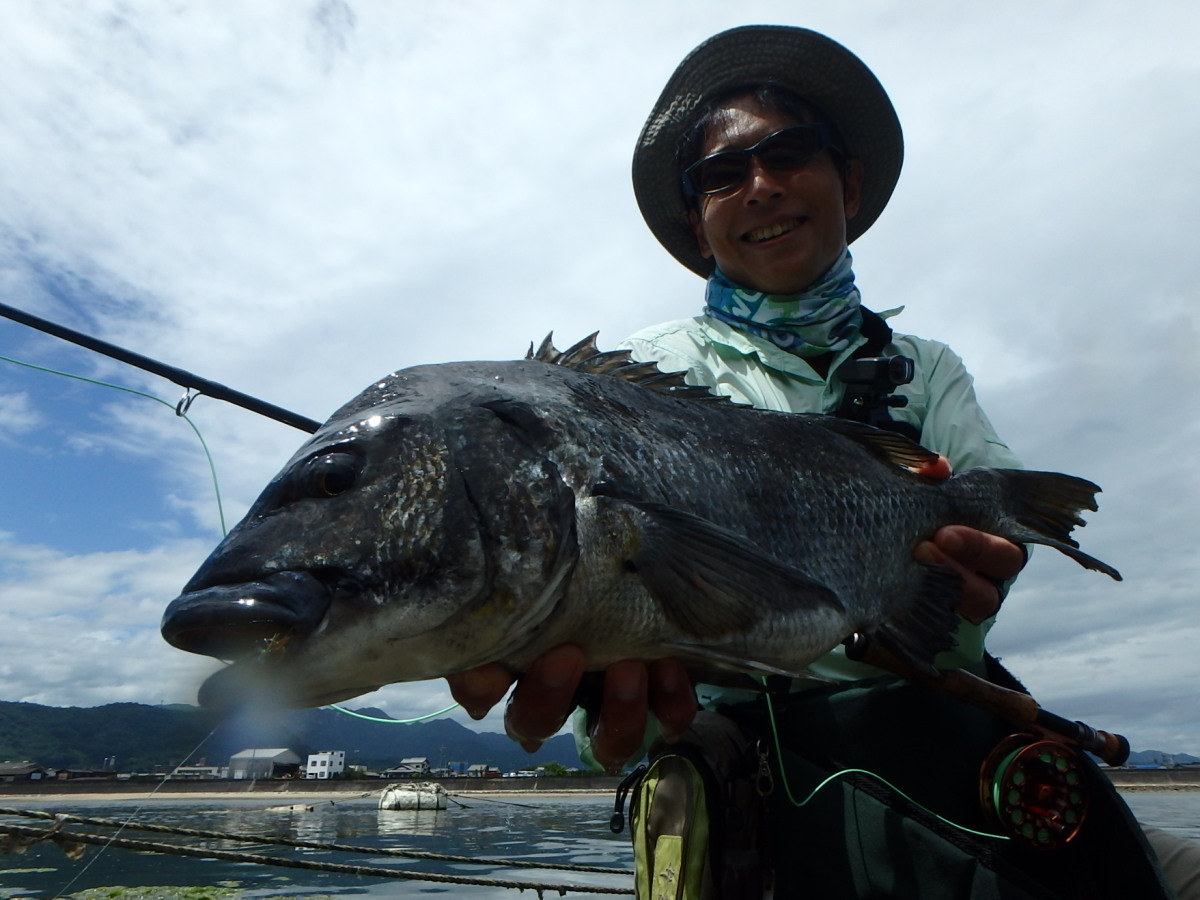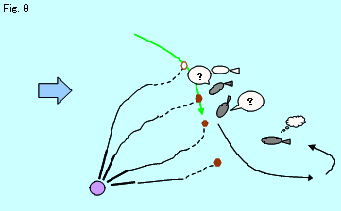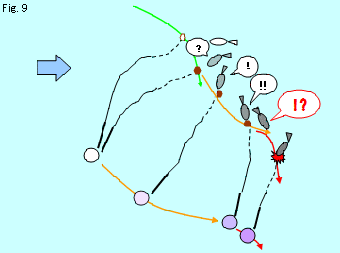2015 update:
Video recorded the bream game.
(subtitles in English).
So I have shared all my findings in bream games thus far and I hope I have
given you enough clues to catch your first bream or two. But there must
be a lot more secrets and tricks to uncover with this long known but newly
discovered flyfishing target. Let us enjoy bream games sharing wisdoms.
- Back
Then you glue the body parts sandwiching the hook, and leave them to dry.
Next day, using threaders and pinsets, twist the rubber cords and make
a knot. Do so in a completely opposite direction to the right and left
legs so that the crab will have their legs evenly and parallelly spread
out.
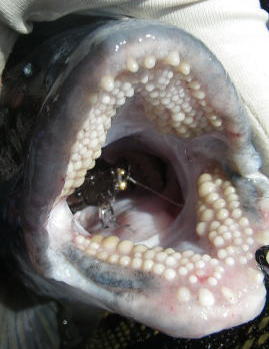

Get along with the sun
Now let's think about the role the sun has to play - the yellow arrow in
the chart left.
The most favorable situation is when the sun is shining from the same direction
as the current. Standing on the upstream with the sun on your back, you can reduce the
risk of being spotted by the fish. Although you are standing in front of
the fish, the sunshine has a blinding effect to the fish swimming up the
current. Not to mention it makes your line control easy as you would in
downcross wet fly fishing.
Think what it would be if the sun is shining opposite the current. You
probably choose to fish with the sun on your back as in the Fig. 11. Sighting
is easy no problem. But by the time you spot the fish, they are right in
front of you or upstream from your position already. Mending the line to
a fish upstream isn't as easy as to fish downstream.

Even a greatest caster cannot always catch fish unless he has an adequate
mending skill. To catch those wary fish, control of the drift is critical.
Think wet fly fishing - when the drift is too fast you mend it upstream,
when the drift is too slow, you mend it down or add some retrieve. All
those technique are assets in confronting breams. The only difference is
in bream fishing you see every movement of your quarries.
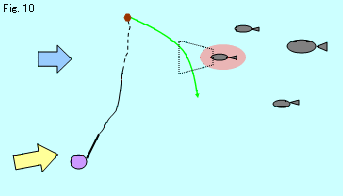
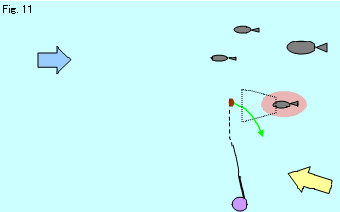
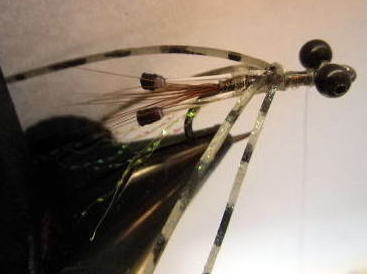
Solid hooking
Once you see inside of their mouth, you understand why your perfect strike
still ends up missing its home often enough. Adult breams boast rock hard
teeth and virtually impossible to set the hook there. Neither your fault
nor that of the hook manufacturer.
When you see the bream finally close in for a kill, try stop your fly for
just a friction of second. Wait till the bream dashes and makes an abrupt stop, before giving it
a slow hand strip strike. That often helps the fly to be gorged into their
mouth for the hook point to find somewhere soft. Even if it doesn't, it
at least gives the fish time to close their beaks, so that the hook may
catch their soft edge of the beaks on its way out.
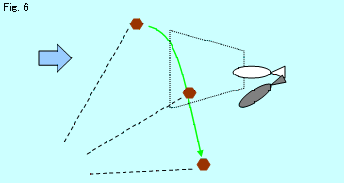
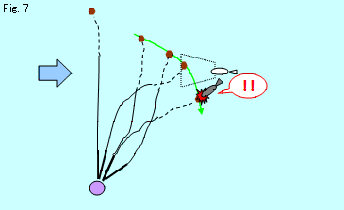
Drifting it in
Let's assume the current is coming from the left as indicated by the blue
arrow in the Fig.. 6. If you are standing on the bottom left corner and
cast downcross, the fly would drift down and pass through the corner of
bream's sight. Because all this movement is created by the current, you
need no retrieve and can keep the distance from the fish.
The fly would approach the fish in the current, and as the fish notices it, the fly starts moving away. This is the perfect set up before proceeding to the teasing stage. If
you feel the line is receiving too much tension and the fly is dragging
too much, mend the line upstream, to slow down the fly just enough for
the bream to catch up.
Being light footed
Now the bream spotted your fly fleeing and on a chase. In a situation as
in Fig. 9, the bream would be closing in with the current pushing on the
right side of his body. As the fly drifts down, the line becomes taut and
the fly starts to receive the drag. This would appear, to the eyes of the
bream, as if his prey is accelerating his movement away from him. If excited
enough by then, the bream could jump onto the fly. But far more often,
he would give up the chase judging it won't worth the trip.
Breams often needs a lot of encouragements. You have to tease them long
enough - longer than any other fish I know of. To enable that without losing
the distance between you and the fish, you should walk with the current easing the line tension and keeping the distance
from the fish as constant as possible. You must patiently keep teasing until you see the fish is heated up and
losing his head, before stopping your foot and deal with the final hooking
stage. More than half the fish I caught fell to the prolonged teasing only
the light footed approach made possible.
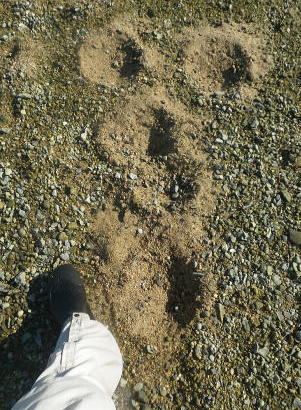
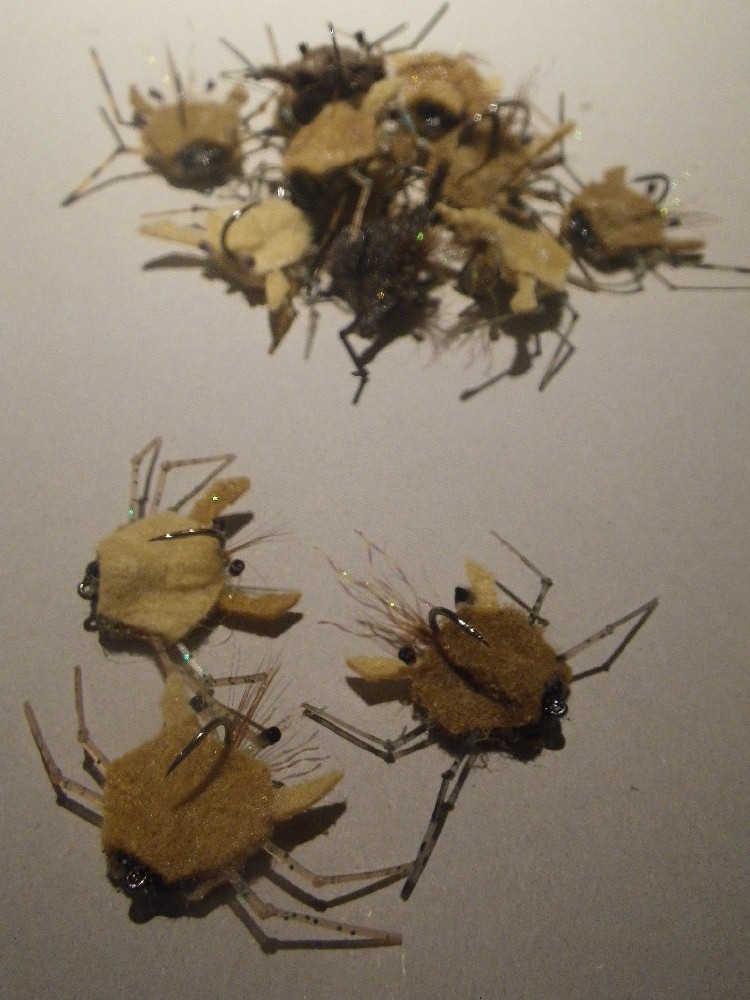
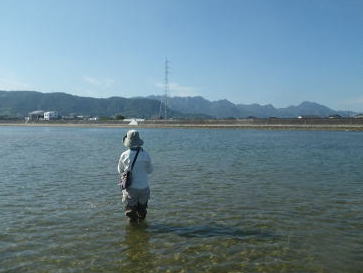
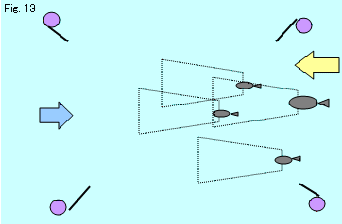
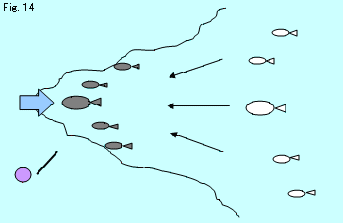
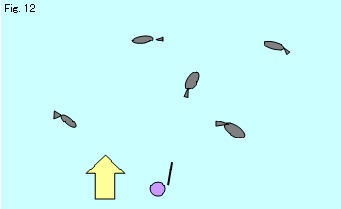
Let us study the case when the sun and the current are moving in a complete
opposite direction. This makes sight fishing very difficult. Especially
so when the sun is low in the morning or in the evening. To make the best
out of it, you should position yourself having the sun on your back - top
right or bottom right position in the chart left - and fish short. Once
you make a good presentation and fish turn to you, as long as you stand
in the sun (in the view of the bream) they cannot see you so easily. Of
course, cast only to the fish closest to you, and never try to chase the
fish showing their back. As I said earlier, breams hate to be fished from
their back.
Even if the field looks even and flat, there always are some gutters and
undulations. The water always finds its way along such features, so do
the fish that are riding in the current. When the sighting condition is
not ideal, one option is to locate such spots where density of passing
fish is higher, and make a short, quiet cast when the opportunity comes.
Hitting the tailing
I have already touched on the tailing fish in discussing the merits of
drifting in technique. But isn't there anything you can do when the current
is too weak to carry your fly? Well, there is one. Not a technique with
great success rate but when it does, it gives you a sensational satisfaction.
Observe and wait. Wait till the fish starts digging up the floor wagging
the tail up in the air. Wait till your fish starts doing that in earnest,
and cast your fly directly onto it. If you succeed in dropping the fly
just when the fish is slapping the surface with his own tail, he won't
notice the noise, only to notice a crab dropping in front of the eyes.
Bon appetit my friend!
You cannot move the sun but you can anticipate the sun's position and plan
your day accordinglr. The sun rises in the east and goes down in the west
- given. The current usually is influenced by the tide which rises and
downs every 6 hours. If you can work out the equation you can tell when
the tide and the sun matches before even leaving home. In fact, this is
one of the fun, strategic part of bream fishing.
Reading thus far, you may ask why I shouldn't look for a place where current
or tidal movement is minimum, so you have one less element in the equation.
To that question I must explain a great benefit the current gives us.
Another benefit of having the current is, as I already mentioned, you can
drift your fly into their feeding zone from many meters above the current.
One typical example is those fish tailing in the shallows, digging up their
lunch from the sand. Those fish in the extreme shallows spook away at the
slightest unnatural sound so you cannot cast the fly directly to the lunch
table. You must cast 3 or more meters away from the fish but because fish
is digging a certain place not moving an inch, there is no hope your fly
gets noticed. That is where you can ride on the current. Watching the line's
coloured butt section drifts, you can control the fly's position accurately
enough, so the fly drifts gently and naturally into the hole the bream
is just digging up.
When there are no current or too weak, fish could move about and face inconsistent
directions. Intentionally or not, they are keeping a 360 degrees vigilante,
making your approach extremely hard.
Whereas when there is current, breams position themselves with their heads
facing upstream, and their movement becomes more predictable. This makes
it much easier to stalk up to the school without being noticed.
Crab fly
Here is how I tie my crab flies.. I use wide gaped hooks in size #6-8,
and tie a set of eyes made burning 30lb fluorocarbon first. Then tie M
size dumbel eye, followed by rubber cords to imitate the legs. I usually
make several flies at a time for better efficiency.
Next I cut out the crab's body parts out of felt in variety of colours.
Place your pointer on the pic left. Again I repeat it number of flies I
want.
Most flyfishers have some degree of experience fishing streams. Reading
the water, drifting the fly and mending the flyline, those are integral
part of bream fishing as it is in dealing with wary browns in snaking spring
creeks.
Though less noticeable, water in the salt flats are also moving, due to
the tide, winds or by the current in case of brack water at river's mouth.
With observation of the movement of the water, you can systematically analyze
the field and predict the whereabouts of your quarries.


First, that movement can only be made by placing yourself right in the
center of the fish's vision. Slightest movement of yours could spook the
fish. Second, the fly's landing position must be very accurately controlled
near enough but not too near. Thirdly, and most seriously of all, the fly
fleeing right on the fish's center of the vision gives no elements of surprise.
Bream will not become interested, or will lose interest more easily.
By contrast, when something crosses the corner of the sight, bream has to turn its head to check. This works as a stimulus to put their
predatory instinct at work. Also this movement can easily be made by angler standing sideways from
the line of the fish, making it less likely for the fish to notice your
presence too soon. And because you are casting crossways, it does not require
super accuratcy - you can adjust the position of the fly even after your
cast, retrieving the line as needed.
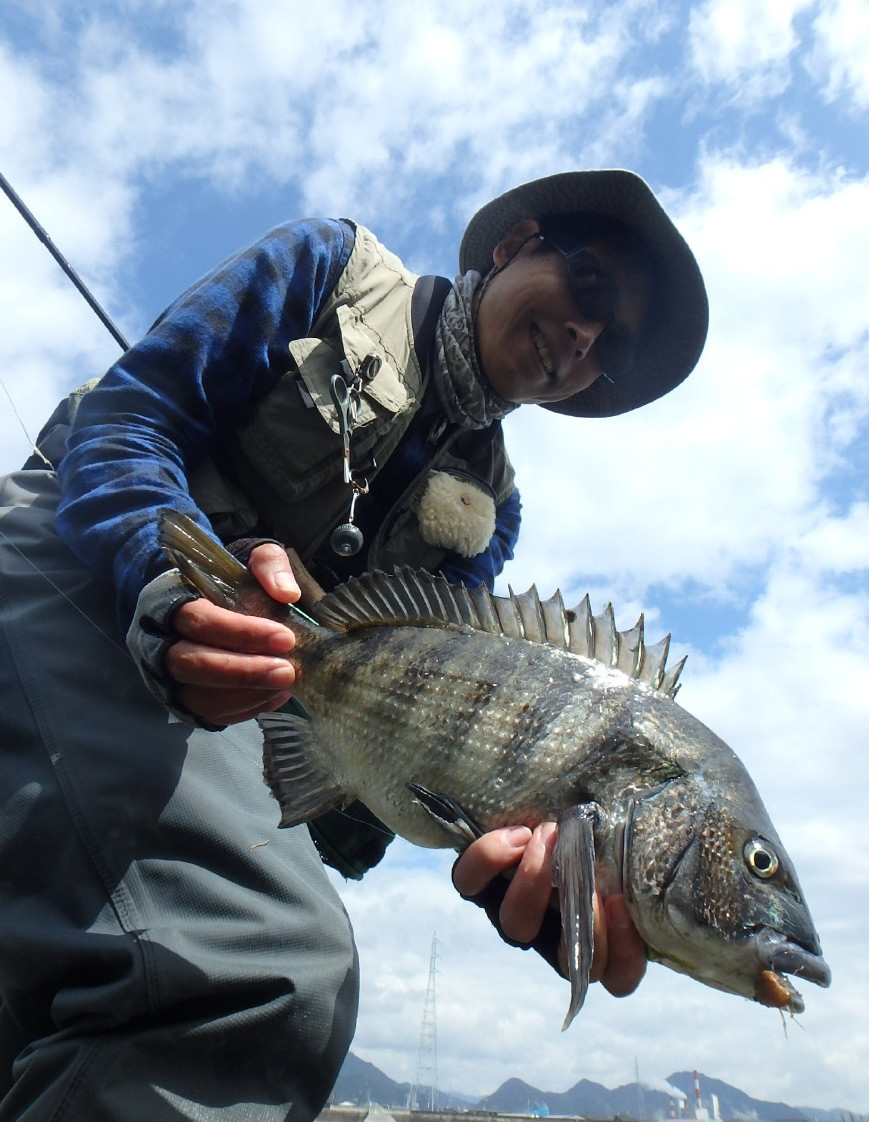
I have described the basics of bream game in the previous chapter but,
as I admitted upfront, you only catch one or two fish for every hundred
fish sighted. It is natural urge for us flyfishers to improve the success
rate even by a percent. I myself am still in the middle of that endeavor
but here are a few such hints that may set you a few steps further.
As I noted already the most effective trigger that appeals to their feeding
instinct is fleeing action of the bait. In a situation as shown in Fig
4, the green arrow pointing straight left is the simplest ways to demonstrate
such. However there are a couple of issues.
 - Advanced techniques -
- Advanced techniques -